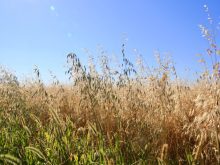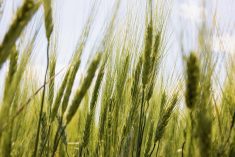
In late July, I got an anxious phone call from Terry, who grows 3,500 acres of durum wheat, canola, flax and peas at his farm about 100 kilometres south of Regina, Sask. Terry was worried about the sorry state of his durum crop — the plants were looking extremely unhealthy and he feared nothing could be done at this late stage to bring the crop back.
I assured Terry I’d come out right away to have a look. When I arrived at one of the affected fields, I could see right away the durum was in pretty poor shape, with a large number of small, sickly looking plants scattered throughout a thin crop stand.
Terry was at a loss to explain what was going on with his durum crop, but suggested extreme environmental stress as one possibility. “It’s been such a wet year,” he said. “I wonder if that has anything to do with it?”
Read Also

Claas brings 1000 Series SP forage harvesters to Canada
In mid-August, Claas unveiled its new line of Jaguar forage harvesters at an event in Visalia, California, deep in the heart of that state’s dairy region.
Walking into a durum field, I noted the symptoms were most noticeable as the crop started to head out through to the soft dough stage of the plant. The affected plants were all stunted, with small heads (some of which were black and sooty), brownish stained lower stems and bottom leaves that had turned completely yellow. I was able to pull plants out of the ground very easily and I observed there was virtually no root mass.
Terry said the same symptoms were occurring in all his durum fields, even though other durum crops in the immediate area that were at the same stage looked completely healthy, with vigorous growth and optimal plant stands.
I questioned Terry about his fertility program, and also asked about his crop protection measures since I had detected a large amount of tan spot on some of the affected plants. However, I knew there had to be much more to the problem than just leaf disease.
Crop Advisor’s Solution: Common root rot and loose smut hurt durum
There were no red flags when Terry told me about his crop protection program and no issues with crop fertility either. Like every year, Terry had applied the necessary amount of nutrients that his agronomist recommended. Drill issues were also ruled out since this would have caused discernable damage patterns in the durum fields and none were evident, and there hadn’t been any plugging or rate monitor problems.
I had spotted a large amount of tan spot on some affected plants during my inspection but I knew there was much more at work here than simply leaf disease. I suspected that at the heart of the problem was poor seed. When I asked Terry if his seed had been tested or if he had treated his seed to protect it against seed and soil-borne diseases prior to sowing, he confirmed he hadn’t done either one.
Clearly, Terry’s durum seed had been poor quality and the lack of seed treatment had compounded the problem. The reason the crop looked so sickly was that it was suffering from a severe case of common root rot and loose smut.
Common root rot is carried on or in the seed and infecting spores may also be present in the top few centimetres of the soil. They can remain dormant for several years until they are triggered to germinate by host plants. Infections can be prevented through a systemic seed treatment as well as seed testing for the presence of seedling diseases like common root rot. If high enough levels of disease are detected, new seed sources may be warranted.
Loose smut can occur wherever durum is grown. Because spores of loose smut are usually dispersed before crops mature, the disease typically doesn’t affect grain quality or yield. Loose smut is easily prevented with a systemic seed treatment.
Sadly for Terry, there wasn’t anything he could do bring the crop back at this late stage of plant development. The damage was already done and the plants were reaching maturity. The yields in the affected durum fields ended up being 40 to 50 per cent less than the previous yields for Terry’s durum crops.
Going forward, I recommended that Terry have his seed source tested yearly. I also urged him to always treat his seed to protect it against seed and soil-borne diseases like common root rot and loose smut, which if left unchecked, can have devastating consequences for a crop. †
Ashley Kelly is a sales agronomist with Richardson Pioneer Ltd. at Corinne, Sask.















